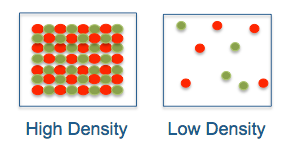High Density vs. Low Density Carbs
High density carbs are ones that per serving size, have a lot of carbs. Low density does not have a lot of carbs per serving although their serving size may be large. Imagine a sponge and brick that are both the same size. They take up the same amount of space, but one is much more dense.
At different times, the different density carbs can be useful.
High density carbs are good when/if:
- You regularly struggle to hit your carb numbers
- You don’t like eating a lot of food volume but need to get carbs
- Post workout, don’t like the full feeling but need carbs
- You don’t feel like eating but have to in order to get to your numbers
Low density carbs are good when/if:
- You want to get a lot of food volume (feel full), but not have a lot of grams of carbs
- You’re “saving” some carbs for a party/event later in the day but don’t want to feel hungry all day, so you eat carbs to get volume (fill space) but not take up your precious party carbs
What scenario are you in? Need a lot of volume with not a big amount of carbs? Need a lot of carbs with not a lot of volume?
High Density Carb Sources (portions may be smaller but have higher carb counts)
- Oatmeal – 1 cup cooked (234 g) – 27 g
- Whole wheat bread – 2 slices (56 g) – 24 g
- Quinoa – 1 cup cooked (185 g) – 39 g
- Rice – 1 cup (158 g) - ~40 g
- Sweet Potato – 1 cup (176 g) – 41 g
- White Potato – 1 cup (176 g) – 38 g
- Banana – 100 g – 23 g
- Barley – 100 g cooked – 29 g
- Whole Wheat Pasta – 100 g – 30 g
- Rice Noodles – 1 cup cooked (176 g) – 42 g
Low Density Carb Sources (portions may be bigger while having an overall lower carbs count)
- Blueberries – 1 cup (148 g) – 21 g
- Cantaloupe – 100 g – 8 g
- Watermelon – 100 g – 7 g
- Kale – 100 g – 8 g
- Brussels sprouts – 100 g – 9 g
- Broccoli – 100 g – 3 g
- Green bell pepper – 85 g – 4 g
You’ll notice that many of the higher density carbs are grains. Many of the lower density carbs are vegetables.
When you’re in need of filling some space up (volume) and don’t have a lot of grams of carbs to do it, turn to vegetables. You can eat a lot of them without spending a lot of grams of carbs.
If you have more grams of carbs available, don’t like eating a lot of food but need to get the grams up for the day, mix in some of the higher density sources.
We would always recommend a gluten free version of the carb, because we believe that although you may not have a reaction from eating gluten, it’s not something that our bodies actually like having ingested and having to process.

